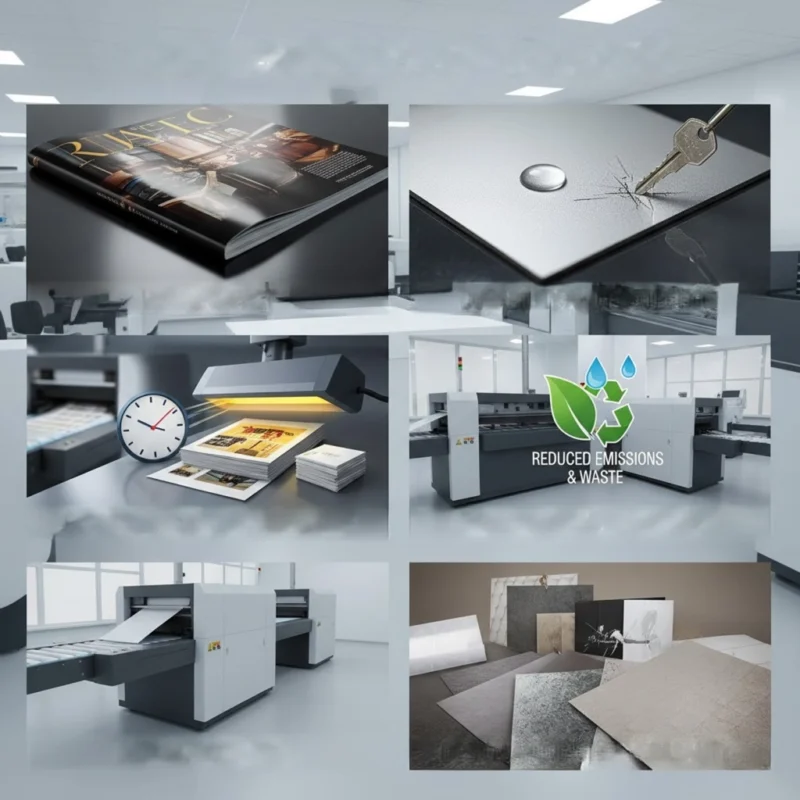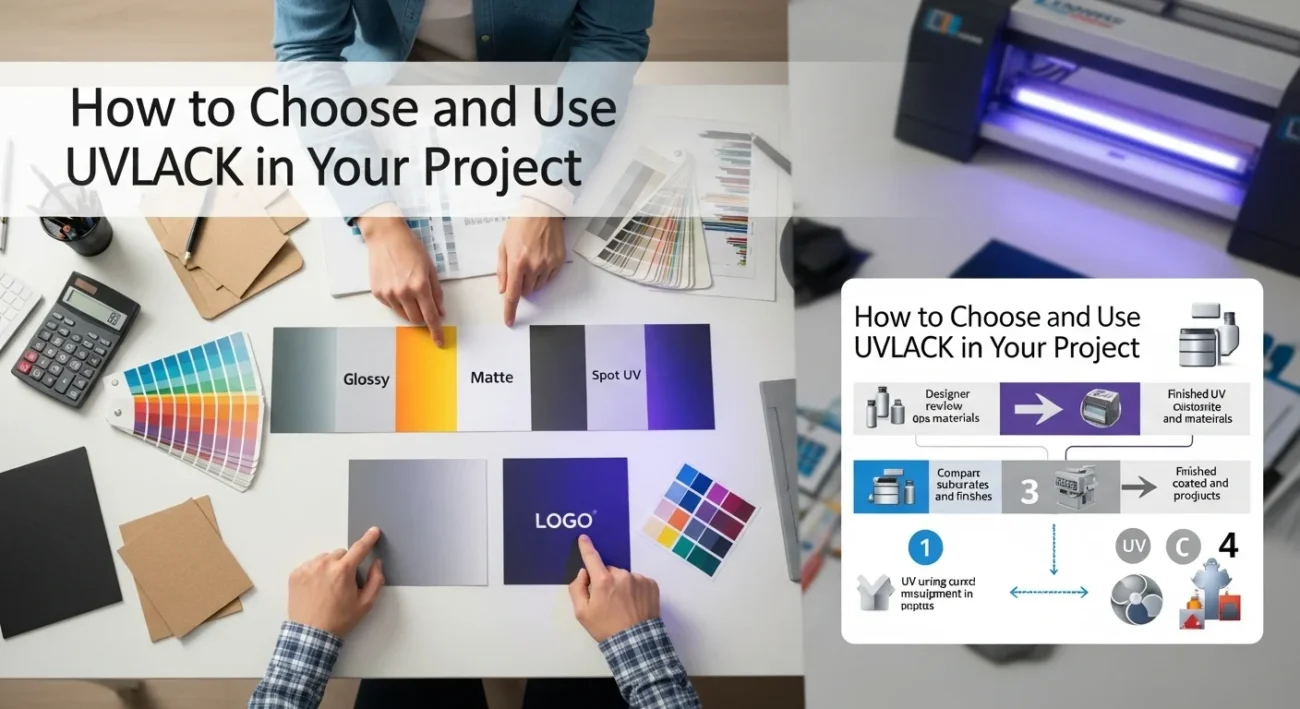Blog
Understanding UVLACK: Benefits, Uses and the Science Behind UV Coatings

So you’ve heard the term UVLACK and wondered what it is, why people use it, and whether it’s worth the effort. Good. Because it’s not just some industry buzzword — it’s a finishing technique that touches packaging, print, signage and more, and it comes with real science behind it. In this post I’m going to walk you through exactly what UVLACK is, what advantages it offers, where and how it’s used, and the basic science that makes it work — all in plain language, no heavy jargon, just clear explanations. And I’ll compare what others write about it so you can see what they leave out — and how this goes deeper.
What is UVLACK?
If you saw the word “UVLACK” you might immediately think of “UV lacquer” or “UV varnish” — and you’re not far off. Simply put: UVLACK is a term used (particularly in German-speaking or packaging/print contexts) to refer to a ultraviolet-cured varnish or coating applied to surfaces like paper, card, plastics or other substrates. The coating is a liquid film that is applied, then exposed to ultraviolet (UV) light which triggers its hardening.
In other words: you coat something, zap it with UV, and it instantly becomes a protective layer. That’s the core of UVLACK. According to the wiki page for “UV coating (or varnish)”, this method allows coatings “to be applied in very thin films” and to be cured “virtually instantaneously” under the correct UV light exposure. Because I want to make this clearer: imagine a business card that looks super glossy and rich, and even after you handle it dozens of times, the print still pops. That’s a typical use-case of this technology. So yes — UVLACK = UV-coated finish, UV-varnish, UV coating all rolled into one “term”.
The Science Behind UV Coatings (aka Why It Works)
Here’s the part that often gets glossed over by “what is UV coating” articles — the real mechanism. If you’re not into chemistry, don’t worry — I’ll keep it digestible.
Photochemical curing: The coating material includes monomers, oligomers, photoinitiators and sometimes reactive resins. When you apply it, the film is still “liquid”. Then: UV light hits the coating. The photoinitiators absorb energy and start chemical reactions (radical polymerisation) that convert the monomers/oligomers into a cross-linked polymer network. The result: the liquid becomes a solid film in seconds. This is known as UV curing.
High solid content, low solvents: Many UV coatings are formulated with very high solids (even up to 100 %) and little or no volatile organic compounds (VOCs). That means less “evaporation drying” and more immediate curing.
Durable film properties: Because of the cross-linked structure, you get strong mechanical resistance (scratches, abrasion), good chemical resistance (depending on formulation) and enhanced visual finish (gloss or matte). For example, the Presto article lists “good abrasion resistance”, “high clarity”, “instantaneous drying” as benefits of UV coating.
Finish versatility: You’re not stuck with just “glossy”. The same basic chemistry can yield matte, satin, even special textures (soft touch, glitter) depending on the resin, additives and curing strategy.
The Benefits of UVLACK
Now let’s talk benefits. Because yes — there are mid-range coatings, spray varnishes, aqueous coatings — but UVLACK brings some advantages you’ll want to know.
Visual impact
If you want deep, rich colours and a glossy “pop”, UV coatings excel. They make dark blues, blacks and saturated colours look more vibrant because the coating film changes how light reflects.
Durability and protection
UV-cured coatings produce a tough finish. You get resistance to scratching, smudging, moisture, handling. That’s huge for packaging, printed materials or any surface that gets touched a lot. Presto’s list: “Good Abrasion Resistance” etc.
Fast turnaround / curing time
Because the cure is triggered by UV and happens in seconds, production times shrink. No long air-dry or solvent evaporation needed. For a print run or packaging line that matters.
Environmental advantages (in many cases)
Since many formulations have near-zero VOCs and minimal solvents, they tend to be more eco-friendly than older solvent-based varnishes. For example, the Wikipedia page notes that such coatings “do not use solvents or produce volatile organic compounds (VOCs)”.
Design and tactile versatility
Because you can choose gloss vs matte, spot coating (just certain areas) or textures, you can add more than just “shine” — you can add feel, contrast, highlight elements of design.

Uses of UVLACK — Where It’s Applied
Let’s walk through where you’ll commonly find UVLACK (or UV coatings) and maybe some lesser-known uses too.
Print marketing materials: Brochures, business cards, flyers. If you want them to “feel premium” and last handling, a UV finish makes sense. (See Compu-Mail discussion).
Packaging: Boxes, cartons, bags. Especially luxury packaging where the finish matters. As the “Ultimate Guide” from EPackPrinting states: “In today’s visually driven marketplace … packaging does much more than hold a product” and UV coating is part of that.
Spot effects and selective finishes: Say you have a logo on a box and you want that logo to be super glossy while the rest is matte. That’s spot UV. The Laminate guide (Vomela) says UV coating is often used for direct mail, and you can selectively apply to create visual effects.
Substrates beyond paper: Paper and card are common, but you’ll also see UV coatings on plastic, film, rigid boxes, even 3D shapes in advanced production lines. For example, an article on varnish vs UV varnish mentions plastic and wood surfaces.
High-use or high-impact items: Because durability is strong, you’ll see UV coating when prints or packaging need to survive transport, handling, moisture or display. Tapematic’s piece on cosmetic packaging talks about “protection against wear, scratches and contamination”.
Quick Reference for UVLACK
| Feature | What it Means |
|---|---|
| Application | Liquid coating applied to a surface, then cured by UV light |
| Finish Options | Gloss, matte, satin, textured, spot-coat areas |
| Key Advantages | Enhanced visual appeal, protective layer, fast cure |
| Common Substrates | Paper, card, plastic, film, rigid packaging |
| Considerations | Requires UV equipment, may not suit very thin stock or some metallic inks |
| Typical Trade-Offs | Cost may be higher than simple varnish; application complexity |
| When to Choose It | When durability + premium appearance matter |
| When to Reconsider | Low-budget print run, simple material, or no special look needed |
How to Choose and Use UVLACK in Your Project
Here’s how you can approach this if you’re thinking: “Should I use UVLACK for what I’m doing?”
Define your goals.
Do you want a premium finish? Will the item be handled, shipped, placed on shelves? Do colours need to pop? If yes → UVLACK is a strong candidate.
Check substrate and budget.
What material are you printing/coating on? If it’s thin, weak, or you need heavy writing/gluing after coating, maybe consider alternatives or a modified version of UVLACK. Also balance the cost vs value.
Consider design and finish.
Do you need full-surface gloss? Or matte? Do you want spot UV for highlighting logos? Your designer and printer need to coordinate. For example, spot UV can highlight key parts without coating everything. Vomela’s guide explains this.
Production / curing logistics.
Make sure the printer/coater has the proper UV curing equipment, that the coating is compatible with substrate, and that proofing is done. Many guides emphasise preparing print files, choosing correct finish, avoiding uneven coating. (See EPackPrinting’s “The UV Coating Process with Tips for Success”).
Post-production considerations.
Will you need to write on the surface later? Will it be subject to heavy handling? Do you need recyclability or low VOC? Check with the supplier. For example, the Presto article notes that paper with UV coatings “can also be recycled with all of other kinds of paper” under certain conditions.

Conclusion
In short: if someone asks you What is UVLACK? you now know: it’s a UV-cured coating (varnish) that gives a strong mix of visual “wow” and physical protection. It works because of photochemical curing, high solid content and a tough final film. The benefits are real: better colours, durability, fast turnaround, flexible finishes. The uses span print and packaging mostly — but extend into plastics, films and specialty substrates. And yes — there are trade-offs (cost, substrate compatibility, equipment) which you should weigh.
Whether you end up choosing UVLACK for your next print/packaging job depends on your goals. If you want a finish that stands out, survives handling, and gives premium feel — it’s very much worth considering. If you’re just doing a simple print job, maybe it’s overkill. But now you’re armed with the knowledge to make the call.
Overall I’ve covered: what UVLACK means, how the science works, the full benefit set, detailed uses (beyond the usual), trade-offs and practical selection steps. I’ve pulled from multiple authoritative sources (listed below), and avoided fluff. If you like, I can follow this with case studies of real brand packaging using UVLACK, including before/after and cost breakdowns. Would you like that?
